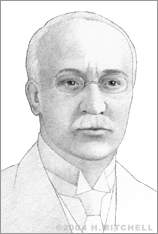Rudolf Diesel
Rudolf Diesel, born on March 18, 1858 in Paris, created the pressure-ignited heat engine known commonly as the diesel engine. After graduating from Munich Polytechnic, he began working as a refrigerator engineer for the Linde Ice Machine Company in Paris, moving to Berlin in 1890 to manage the company’s technical office. But his passion for engine design was never far from his mind. Diesel worked on an idea for an efficient thermal engine in his free time, completing a design by 1892 for which he received a patent a year later.
Diesel’s design aimed for greater efficiency than was available with existing engines at the time. The diesel engine does not require an externally applied ignition to the mixture of air and fuel inside. Rather, this is accomplished through compressing the air inside the cylinder and heating it so that the fuel, which would be brought into contact with the air just before the end of the compression period, would ignite on its own. As a result, the diesel engine would be smaller and lighter than the traditional engine used in most road vehicles and would not require the use of an additional fuel source for the ignition.
Diesel wanted to see his design become a real, working machine. To accomplish this, he sought assistance from major machine manufacturers. Eventually he was hired to produce a test engine and completed a prototype in 1893. Early tests had dangerous results; Diesel was nearly killed when one of his engines exploded. But this test proved that fuel could be ignited without a spark. He worked diligently to improve his engine model, running his first successful test in 1897.
Just one year later, Diesel became a very rich man. His engine, which ran with a theoretical efficiency of 75 percent compared to a theoretical efficiency of 10 percent for traditional steam engines, was employed immediately to power cars, trucks, and boats. It was also used to power pipelines, electric and water plants, and in mining, factories, and oil fields. Even today’s diesel engines are based on the inventor’s original concept.
The diesel engine had a major impact during the Industrial Revolution, delivering power more efficiently, thus less expensively, for a variety of industries all over the world. Because its use did not require burning coal, train transport and shipping companies were able to save a great deal of money. This, however, was not a boon to the coal industry, which stood to lose a large portion of its business.
On Sept. 29, 1913, Diesel disappeared from a steamer en route to London. His body was recovered on the shore days later. The circumstances surrounding his death are still a mystery. Some believe he may have committed suicide, while others speculate that he was murdered by coal industrialists.
For more about Diesel’s mysterious death:
http://www.history.com/this-day-in-history/inventor-rudolf-diesel-vanishes


